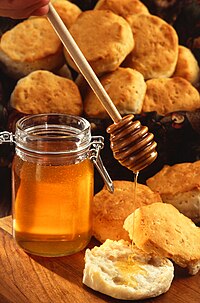
Photo from wikipedia
The aim of the study was to compare the content of selected minerals in different nectar honeys (acacia, buckwheat, raspberry, linden, rapeseed, and multifloral) available on the Polish market. The… Click to show full abstract
The aim of the study was to compare the content of selected minerals in different nectar honeys (acacia, buckwheat, raspberry, linden, rapeseed, and multifloral) available on the Polish market. The degree to which the demand for eight minerals (K, Na, Mg, Ca, Zn, Fe, Mn, Cu) by adults is met by a portion of 100 g of honey was estimated as well. The material consisted of 34 artisanal honeys from direct sale and 34 samples purchased from retail stores. The artisanal honeys contained significantly more K, Mg, and Mn, but significantly less Na and Fe than the honeys purchased from the retail stores. The raspberry honey contained significantly the most K and Ca (1104.7 and 68.8 mg kg−1), the multifloral honey contained the most Ca and Mg (68.5 and 48.0 mg kg−1), and the buckwheat honey contained the most Zn and Mn (3.97 and 4.96 mg kg−1). The highest content of Na was shown in buckwheat and linden honeys (79.1 and 80.0 mg kg−1). Consumption of 100 g of honey from direct sale satisfied from 2.5 to 4.5% of the recommended intakes for K and from 10.4 to 17.3% for Mn, while the same portion of honey from retail satisfied from 1.6 to 4.8% for Fe, and from 2.3 to 6.1% for Zn and Cu. The buckwheat honey met to the greatest degree the recommended dietary intakes for Mn (16.5–27.6%), followed by raspberry honey (10.0–16.7%) and multifloral honey (6.9–11.6%).
Journal Title: Biological Trace Element Research
Year Published: 2018
Link to full text (if available)
Share on Social Media: Sign Up to like & get
recommendations!